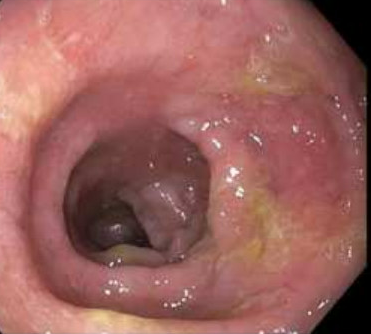Sunday Poster Session
Category: IBD
P1219 - Infectious Clues to Late-Onset IBD: A Case of Persistent Colitis
Sunday, October 26, 2025
3:30 PM - 7:00 PM PDT
Location: Exhibit Hall
- CM
Christopher A. Miquel-Chambers, MD (he/him/his)
University of Florida Health Shands Hospital
Gainesville, FL
Presenting Author(s)
Christopher A. Miquel-Chambers, MD, Mary A. Bramlage, MD, Hannah Zuercher, MD, Naueen Chaudhry, MD
University of Florida Health Shands Hospital, Gainesville, FL
Introduction: Inflammatory Bowel Disease (IBD) in the setting of a complex infectious history presents distinct clinical and therapeutic challenges. IBD can potentially be triggered by infections, such as Salmonella, through mechanisms which cause immune dysregulation.[1,2] This case report describes a 68-year-old female with late-onset IBD and a complex infectious history.
Case Description/
Methods: A 68-year-old female with history of hypertension treated with Olmesartan and subacute diarrhea presented with fatigue and weakness. She had multiple hospitalizations in the prior 4 months with E. coli, Plesiomonas shigelloides, and amoebiasis infections diagnosed and treated in the Philippines, but due to ongoing diarrhea we repeated colonoscopy here in the US with pathology diagnostic for CMV. Despite brief, intermittent periods of improvement, her condition worsened eventually with failure to thrive. Initially, we were concerned for multifactorial etiology including Salmonella due to a positive stool PCR, refractory CMV colitis, or Olmesartan enteropathy (OE). Her MRE and colonoscopy showed colonic inflammation with chronic active colitis, and her gastric biopsy was not consistent with OE. Despite treatment and supportive care, her diarrhea and weight loss worsened to the point where she needed TPN. Her repeat colonoscopy showed mildly improved chronic active colitis, consistent with IBD, and her symptoms improved with steroids. She continued to improve on steroid taper and sulfasalazine outpatient. She regularly follows up with the IBD clinic and her diarrhea has resolved with improving nutritional status.
Discussion: Late-onset IBD can be challenging to diagnose in the presence of overlapping, prolonged infections. Salmonella is associated with a 2.9-fold increased IBD risk due to disruption immune system homeostasis via NF- κB and IL-8 pathways.[1,2] Her persistent symptoms despite antibiotics, combined with elevated inflammatory markers and a positive response to steroids supported IBD.[3,4] Although OE mimics IBD, it was less likely to cause worsening after discontinuation and her pathology was not consistent with OE.[5,6] Her complex and prolonged infectious history highlights pathogens’ role in triggering IBD in and can be a red herring for new onset IBD.[2,7] While steroids were effective for induction, long-term strategies for late-onset IBD require further research.[3,4] This case is an important reminder that infections can mask IBD and lead to severe illness as seen in our patient.

Figure: Hepatic Flexure showing granularity with marked erythema and a decreased vascular pattern
Disclosures:
Christopher Miquel-Chambers indicated no relevant financial relationships.
Mary A. Bramlage indicated no relevant financial relationships.
Hannah Zuercher indicated no relevant financial relationships.
Naueen Chaudhry indicated no relevant financial relationships.
Christopher A. Miquel-Chambers, MD, Mary A. Bramlage, MD, Hannah Zuercher, MD, Naueen Chaudhry, MD. P1219 - Infectious Clues to Late-Onset IBD: A Case of Persistent Colitis, ACG 2025 Annual Scientific Meeting Abstracts. Phoenix, AZ: American College of Gastroenterology.
University of Florida Health Shands Hospital, Gainesville, FL
Introduction: Inflammatory Bowel Disease (IBD) in the setting of a complex infectious history presents distinct clinical and therapeutic challenges. IBD can potentially be triggered by infections, such as Salmonella, through mechanisms which cause immune dysregulation.[1,2] This case report describes a 68-year-old female with late-onset IBD and a complex infectious history.
Case Description/
Methods: A 68-year-old female with history of hypertension treated with Olmesartan and subacute diarrhea presented with fatigue and weakness. She had multiple hospitalizations in the prior 4 months with E. coli, Plesiomonas shigelloides, and amoebiasis infections diagnosed and treated in the Philippines, but due to ongoing diarrhea we repeated colonoscopy here in the US with pathology diagnostic for CMV. Despite brief, intermittent periods of improvement, her condition worsened eventually with failure to thrive. Initially, we were concerned for multifactorial etiology including Salmonella due to a positive stool PCR, refractory CMV colitis, or Olmesartan enteropathy (OE). Her MRE and colonoscopy showed colonic inflammation with chronic active colitis, and her gastric biopsy was not consistent with OE. Despite treatment and supportive care, her diarrhea and weight loss worsened to the point where she needed TPN. Her repeat colonoscopy showed mildly improved chronic active colitis, consistent with IBD, and her symptoms improved with steroids. She continued to improve on steroid taper and sulfasalazine outpatient. She regularly follows up with the IBD clinic and her diarrhea has resolved with improving nutritional status.
Discussion: Late-onset IBD can be challenging to diagnose in the presence of overlapping, prolonged infections. Salmonella is associated with a 2.9-fold increased IBD risk due to disruption immune system homeostasis via NF- κB and IL-8 pathways.[1,2] Her persistent symptoms despite antibiotics, combined with elevated inflammatory markers and a positive response to steroids supported IBD.[3,4] Although OE mimics IBD, it was less likely to cause worsening after discontinuation and her pathology was not consistent with OE.[5,6] Her complex and prolonged infectious history highlights pathogens’ role in triggering IBD in and can be a red herring for new onset IBD.[2,7] While steroids were effective for induction, long-term strategies for late-onset IBD require further research.[3,4] This case is an important reminder that infections can mask IBD and lead to severe illness as seen in our patient.

Figure: Hepatic Flexure showing granularity with marked erythema and a decreased vascular pattern
Disclosures:
Christopher Miquel-Chambers indicated no relevant financial relationships.
Mary A. Bramlage indicated no relevant financial relationships.
Hannah Zuercher indicated no relevant financial relationships.
Naueen Chaudhry indicated no relevant financial relationships.
Christopher A. Miquel-Chambers, MD, Mary A. Bramlage, MD, Hannah Zuercher, MD, Naueen Chaudhry, MD. P1219 - Infectious Clues to Late-Onset IBD: A Case of Persistent Colitis, ACG 2025 Annual Scientific Meeting Abstracts. Phoenix, AZ: American College of Gastroenterology.
